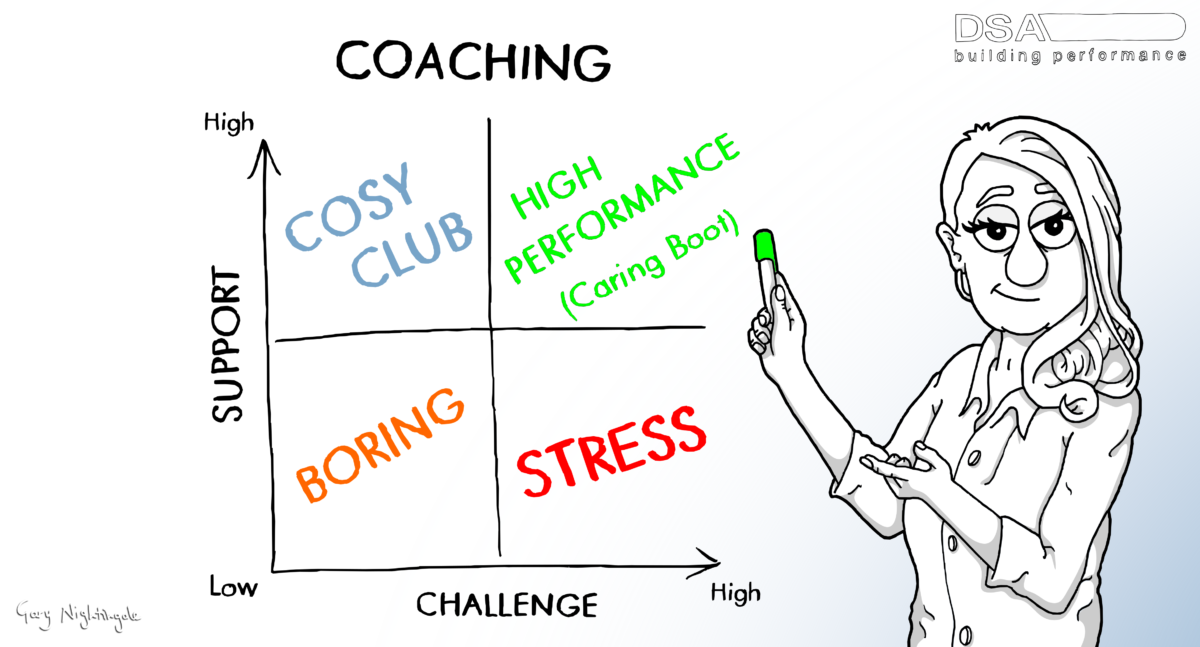“If someone had just listened to me, I think I would have got through it”

John had a breakdown six years ago. He’s okay now, though he never returned to work.
I heard his story on a BBC Radio 4 dial-in programme about mental health a few years ago. This is how I remember it.
John explained that as a manager he thought his job was to increase pressure on people so they achieved more. Times were hard, so people had to work harder.
John was working hard, too, but unfortunately for him, his boss also thought his job was to increase pressure on people and John was first in line. His boss piled so much pressure on that John cracked under the strain.
“I had a nervous breakdown and couldn’t come to work,” he said.
The radio host was empathetic and softly asked, “What would have helped back then, John?”
“If someone had just listened to me, that would have made the difference,” John said. “I think I would have got through it.”
What John was getting (and giving) was all challenge and no support.
Challenge plus support
John’s story highlights the clumsy, black-and-white approach management often takes to getting more out of staff.
It’s an approach that tends to one of two extremes: implacable, unremitting pressure at one end, and gushing, uncritical praise at the other.
In their fine book, Challenging Coaching, John Blakey and Ian Day offer an extremely useful way of thinking about the issue, in the form of the “Challenge and Support model”, pictured above.
As you can see, there are two axes. “Challenge” runs horizontally along the bottom from low to high, while “Support” runs vertically, also from low to high.
With its four quadrants, the model shows what happens when our interventions as leaders do not strike a balance between the two.
When both challenge and support are low it’s the realm of boredom. Managers are disengaged; they don’t care particularly either way, and neither will their staff.
If I as a coach provide low challenge and low support, the team I’m working with would be justified in sacking me.
“We could have a chat or argue among ourselves just as easily without you, Dave,” they would be right in saying.
If I got nervous and whacked up the support dial without any complementary challenge, that’s the Cosy Club.
I’d spend all day yelling: “Amazing, guys! You’re the best! I can’t believe how you did that! Brilliant!”
We all need a bit of that; it feels good. But it also leads to complacency and, ultimately, disillusionment.
If I then over-correct and whack up the challenge dial without support, we enter John’s hell described above.
It’s the realm of pure stress, which breeds fear, blame, unclear thinking, uneven results, poor health and high staff turnover.
The high-performance sweet spot
The sweet spot for high staff performance is the top right quadrant, where both challenge and support are high.
Here, managers are totally engaged, asking big things from staff but offering big support, too.
It’s not a license to act insane, mind you, screaming abuse in one breath and lavishing praise the next; both challenge and support must always be constructive, proportionate and intelligible.
I work with executive teams who want to be challenged; they are high achievers and thrive on it.
But I’m careful about the balance because sometimes it all gets too much.
At the start of one session, I asked a leadership team which quadrant they wanted to work in that day. “Cosy Club,” was the unanimous response.
Surprised, I asked why. “We’ve had a hell of a quarter, Dave,” the MD said. “We just need to come up for air and get our breath, slow down and regroup.”
So, we did Cosy Club.
After the mid-morning break, I asked how everyone was doing.
“That’s enough Cosy Club Dave,” the MD said. “Bring it on, we’re good to go.” So we stepped up the challenge.
Later, having tackled some really tough issues and nervous that I was overdoing it, I asked them to rank how challenged they felt on a scale of zero to 10. The consensus was about four.
I’m constantly amazed by people’s resilience and capacity for challenge.
This model is not just for coaches
If you’re a manager and you’re not getting the challenge-support mix right with your people, they are probably bored or too stressed, and that is a risk for your business.
Chances are, your people could use some extra support right now.
Working all day in the box bedroom with the kids fighting on the other side of the thin partition is exhausting.
My top five supportive interventions
Here are some supportive interventions that are constructive, proportionate and intelligible:
1. Give encouragement for effort or perseverance;
2. Acknowledge a job well done and celebrate it;
3. Listen to concerns, without interrupting or jumping in with solutions;
4. Give permission to take a guilt free break: some time helping out with the family or going for a walk;
5. If their situation is serious, refer them to a professional. (Not me, by the way, I’m a coach not a counsellor.)
How to crank up challenge
Here are some ways to increase the challenge in a way that is constructive, proportionate and intelligible:
1. Ask people a stretching, open question and stay silent so they think about it;
2. Set a stretching target with a by-when date;
3. Ask them to account for their commitments and progress;
4. Bring it back to them, asking, “What are you avoiding, what’s your responsibility here?”;
5. Ask, “what’s the purpose here, why are we doing this?”.
Back to John and his breakdown: maybe he didn’t ask for or get the support he needed six years ago.
What about you, now? Are you getting the support-challenge mix you need? Are you giving it?

